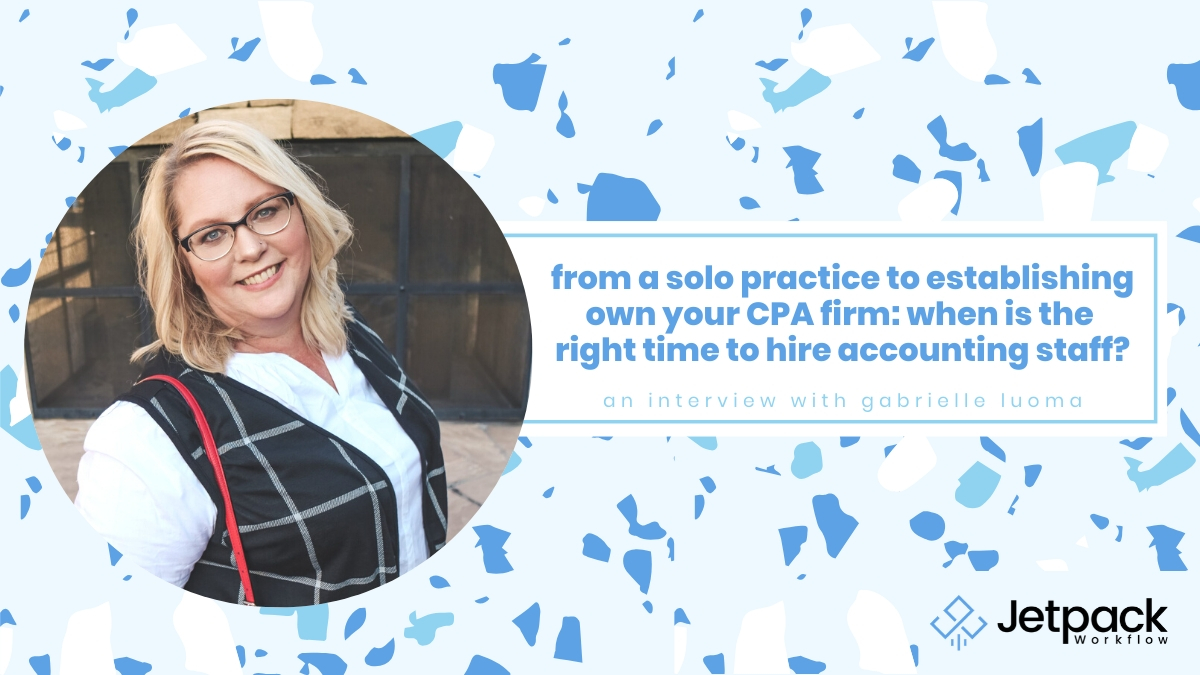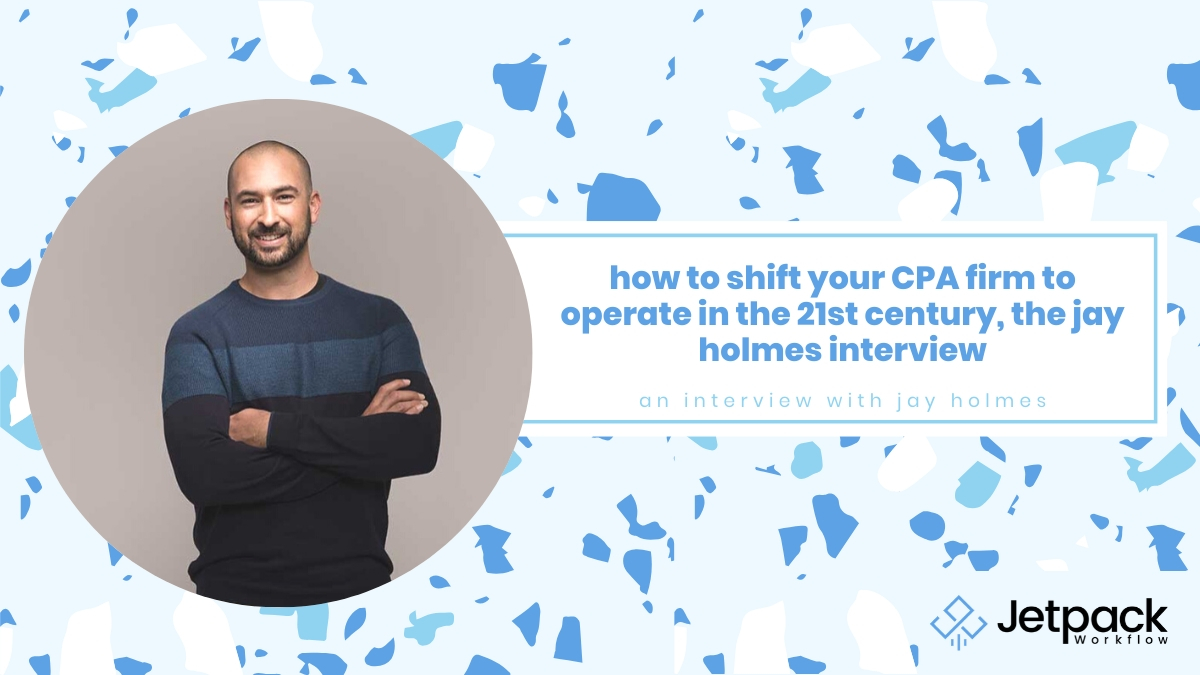From a Solo Practice to Establishing Own Your CPA Firm: When Is the Right Time To Hire Accounting Staff?

You did it! You made the decision to launch your very own CPA practice. Your client base is starting to grow and so is the workload…but when is the right time to bring on staff to help you meet and exceed your clients needs? Join us as we chat with Gabrielle Luoma, Founder of the Tucson AZ based, GML CPA firm, who talks about when is the right time to hire accounting staff as you Grow Your Firm.
In this episode, we will discuss:
- Testing the business waters
- Transitioning from a solo effort to an established firm
- Setting big business goals
- When the time is right to start hiring staff
- And so much more!
Part 1
Part 2
Key Resources:
GML Website: www.gmlcpa.com
GML Email: info@gmlcpa.com
Gabrielle’s LinkedIn: https://www.linkedin.com/in/gabrielleluomacpa
Gabrielle’s Direct Email: gluoma@gmlcpa.com
Testing the Business Waters
Gabrielle Luoma never saw herself as an entrepreneur or owner.
Yet in just over 10 years, Gabrielle is now running GML CPA, a diversified services CPA firm with seven employees.
In 2004, Gabrielle had her youngest daughter and spent that year not knowing which direction to go. She set a small goal for herself: To make $500 per month from preparing individual tax returns.
By 2006, Gabrielle saw that her business reach could grow and that she could go to the next level. So she began to market herself to the public.
Gabrielle placed an ad in the local HOA community newsletter and became excited each time she received a call. After tax season, Gabrielle was able to pick up first business client.
But what was next for Gabrielle? Admittedly, she did not know where to begin and she never set a business goal. It was all about taking baby steps. She made the effort to conduct ongoing engagements with the business community. She started to meet her business goals by building upon the skills she already had. Soon enough, her small business revenues went from $500 per month to $750 per month. “It was really pretty cool,” said Gabrielle.
Transitioning From a Solo Effort to An Established Firm
By 2007, Gabrielle decided it was time to transition her business to a full-time effort. First she secured an office space because she did not want people coming to her home, and she wanted to be taken more seriously.
Although Gabrielle believes that idea has changed now with the cloud and virtual business practices. “So funny to say that now that we are in 2016. You don’t really need an office space in order to be taken seriously, but back then, it felt like you really did.”
Setting Big Business Goals
Now her business goal was to make between $75,000 and $100,000 per year. For her, it was a big goal.
To achieve this goal, Gabrielle knew she had to step up her marketing efforts and learn how to connect with customers. Her first hurdle was her shyness and to overcome it, she focused on what she could easily and repeatedly talk about:
1) Income tax returns
2) QuickBooks training
3) Small business bookkeeping
Next, she joined a weekly BNI networking group that was quite popular during the time and met with same 20 or 30 business owners who referred work to her.
As business grew, she looked for strategic placement opportunities in front of potential customers. Gabrielle sponsored networking breakfasts and events where business owners convened to get her name out there.
Gabrielle’s consistent efforts made impacts in laying the foundation and building relationships.”
She now had a referral network in place from her long-standing, “solid” relationships with strategic partners including financial planners, employee stock valuation experts, and insurance agents whom she trusted and who trust her.
Her partners share the same values and thinking processes and are like an extension to her business.
Time to Hire Staff
As her business grew, Gabrielle hired her first employee, a bookkeeper, in 2007. This person handled all the bookkeeping and accounting work so Gabrielle could focus on income tax work.
Gabrielle realized quickly that she did not have any work processes in place. Since she was never a business owner, she did not know how to provide for employees. “It was a train wreck,” admits Gabrielle.
In 2009, Gabrielle hired on a second employee, and with this new hire, Gabrielle had a new set of expectations. She was now organized in what she wanted and ensured that good processes were in place, although she notes that she is always learning.
Gabrielle offers suggestions on how to determine which areas or roles to hire for first.
- Pay rate – Start by filling a role that pays at a lower rate: Bookkeeper vs. CPA
- Work hours – Begin with a part-time hire and add hours as your business scales
- Training time – The first hire requires much more time to train, and with each subsequent hire, required training time is marginally less.
In the beginning, she managed all of the work, and now she doesn’t have to do it. Her staff handles particular areas of the business and reports back to her.
Gabrielle suggests building a business “that pays you.” Look at your own business to see if you are charging your clients enough to cover your expenses and meet your profit targets.
Take into consideration your overhead and what you would have to pay someone to do the job.
With additional hires, a business owner has a lot to keep track and promote including:
- Positive working environment that fosters accountability
- Client care culture
- Work expectations of employees and of management
Every step is the next step up to grow your firm. Today, she has seven people working at GML. Gabrielle is proud of what she has created so far. The staff get along well and “really do love each other.” While she has had situations where the person was just not the right fit, after a departure, they all still remain friends.
Creating and fostering the right culture for your firm does not happen overnight and every year it can get better. Gabrielle says it takes a lot of hard work by everyone in the firm but ultimately where she is at, “it’s great and I love it.”
Her Business Today
With her team in place today, Gabrielle has been positioned to grow to the next level, expanding her reach to small businesses. Her firm now offers accounting, tax, CFO services, outsourced accounting, and business consulting.
Gabrielle started working with the Value Pricing model in 2011 mainly as a way to pay her staff. Gabrielle transitioned from charging an hourly rate to a fixed rate then to a value rate.
Through her tax and accounting work, Gabrielle was able to see what the industry has been charging for services by the hour. To determine a fixed price per annum, she average out the hours per job.
Making the step to value pricing was harder. She decided to start charging a value price with new clients first and then gradually introduced it to existing clients.
Value pricing is a new experience for business clients, and if they are open to it, it sets the stage for a good, negotiated plan for both.
The hard part about implementing the Value Pricing model is having to communicate to clients why prices would rise.
Gabrielle thinks it is a simple as being honest. In some cases the clients may not be fine with the reason, and she believes that those clients may not be right for you.
“One goes away and another will come. The ones that stay become happier because they are getting better service. It all works out in the end.”
Gabrielle’s services are not just transactional but consultative. She and her team address situations and may bring on strategic partners to provide additional value. They ask questions to understand what the business is about, and then they determine what are the “pain points to fix.” They meet with some of their clients on a weekly basis and act as an insider CPA role, remaining “in the trenches.”
“Clients are not used to that conversation from CPAs. They are not used to be asked all of these questions,” says Gabrielle. If you figure out how to help them, “usually you get a client for life.”
And hiring accounting staff to great a working team is important to support and grow your client relationships.








